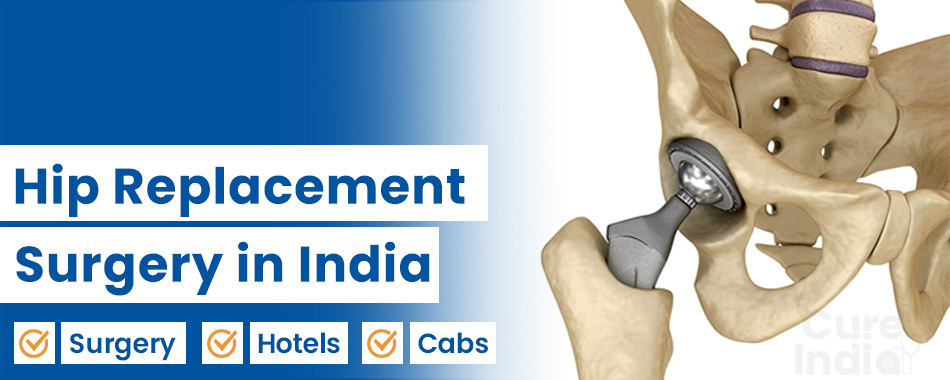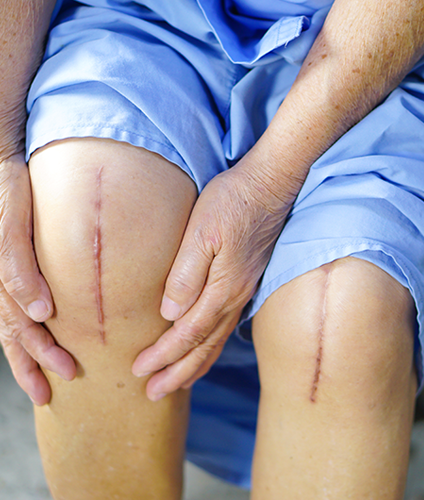

The African continent has several barriers to quality healthcare, namely, poor physical health infrastructure, scarcity of health facilities and huge amounts of waiting time. Every year, many Africans cannot afford appropriate and on-time treatment for diseases such as severe hip joint pain or arthritis. This is why they start seeking medical facilities in other countries such as India.
India has become popular for a total hip replacement operation because of the affordable operation costs and professional surgeons. If we compare with the rates in the Western world, the total hip surgery cost in India is even less than 20% cost of surgeries conducted in developed countries. However, the hip replacement surgery cost in Indian hospitals is much lower compared to the same in developed countries, while the hospitals have experienced surgeons and technological facilities. Also, in modern India, there are many advanced, minimally invasive techniques for total hip surgery and accessible custom treatments. Also, high success rates are achieved by India for such operations, which frequently range between 70-80 per cent. Thus, the patients can come with confidence in order to get an excellent outcome of the total hip replacement operation in India.
Also, the quality of Indian medical tourism includes facilities for travel accommodation and recovery after the operation. Thus, it creates a consistent, warrantied, and less expensive trip for those patients coming from Africa. The total hip replacement operation in India aims to correct mobility disorders and improve the patient’s quality of life.
Walking and getting in and out of chairs may be excruciatingly painful and difficult if your hip has been injured by osteoarthritis, a fracture, or one of the many other disorders that can cause hip injury. Wearing shoes and socks might be difficult if your hip is tight. Even if you're lying down, you may find it difficult to relax because of the hip injury.
Total hip replacement is a procedure in which a physician operates to remove a damaged hip joint suffering from arthritis and implants an artificial joint usually consisting of a metal and a plastic part. Arthritis is caused in the hip joint either because the surface of the hip socket or the head of the thighbone has been damaged. This causes heavy pain, and the patient has difficulty walking or even performing next-to-impossible tasks throughout the day. In most cases, hip joint replacement surgery is used when other methods aren’t effective and the pain is still present. After you replace your hip, the pain during movement of your hip joint is eliminated, and so you move more easily.

You may want to consider getting a total hip replacement operation in India if using the medicine, making adjustments to how you usually do things, and using walking aids like canes or crutches aren't cutting it for you in terms of relieving your pain and symptoms. You can relieve your discomfort, improve your range of motion, and return to the things you love to do with a total hip replacement surgery procedure.
The total hip replacement operation in India is among the most effective procedures ever performed in medicine. Improved joint replacement surgical procedures and technology dating back to the early 1960s have made total hip replacement far more successful than it was.
These days, the total hip replacement operation in India is done using the latest equipment, and advanced technology and by the best doctors at the most affordable rates. The total hip replacement operation in India is preferred worldwide for its efficiency, good quality and low costs.
A total hip replacement operation in India is usually recommended when hip pain becomes severe and starts affecting daily activities. Common candidates for this surgery are adults over 50 years old who experience chronic pain in the hip joints. If non-surgical treatments, like physiotherapy or using walking aids, do not provide relief, hip joint replacement surgery may be necessary.
Several symptoms indicate the need for surgery. Pain in the hip after exercise or physical activity is a major warning sign, especially if it persists despite taking pain relievers. Nighttime pain that disrupts sleep also suggests worsening hip issues. Stiffness in the joints causes hardness to bend or complete daily tasks. Additionally, difficulty walking even short distances is a reason to consult an orthopaedic specialist.
The total hip replacement operation in India helps restore mobility and reduces pain. If left untreated, severe hip problems can worsen over time. A timely consultation with a doctor is essential to determine if surgery is the best solution.
People between the ages of 50 and 80 are the most common ones to get hip replacement surgery done. The total hip replacement surgery is usually carried out to treat arthritis caused at the hip joint.
Arthritis is a disorder that is responsible for breaking the cushion between the bones, known as cartilage. Without cartilage, when the bones rub against each other, severe friction is caused leading to heavy pain between the joints.
A total hip replacement operation in India mainly treats three types of arthritis:
Initially, doctors prescribe and resort to several methods to treat arthritis. This may include the use of walkers, physiotherapy, and non-steroidal anti-inflammatory drugs (NSAIDs) such as ibuprofen. If your arthritis does not respond to such medical measures, getting a total hip replacement surgery may seem like the best solution. However, a hip replacement surgery can also be used to treat several other health conditions.
The replacement hip that would be planted in place of your old hip is made up of four components:

For joint prosthesis, you may be offered several options from your doctor.
Most doctors go for and highly recommend un-cemented joint prostheses. This procedure allows your bone to grow into the prosthesis over time. This kind of prosthesis may take longer than usual to stick to the bone and hence the recovery time is also longer.
On the other hand, a cemented prosthesis is attached to the hip with bone cement for quick attachment. This is a better option for adults, especially the older ones (who are not very active) as this is quicker.
This hip replacement procedure is generally performed through the anterior or posterior, which spares cuts through the muscles, thereby reducing pain and recovery time.

The total hip replacement surgery cost may vary across the world. Where countries like the USA, UK, and Canada may provide surgeries at expensive costs, countries like India are more cost-effective and affordable for getting hip replacement surgery with the same quality and brand. India is now a preferred medical destination for the treatment of quite a few specialities like dental, orthopaedics, and IVF treatments in India.
CureIndia is a platform that bridges the gap between medical tourists seeking treatment in India and the state of the hospitals in India. It helps you choose the right doctor for your hip replacement surgery in India. Most of the doctors in the top hip replacement hospitals in India have been internationally trained and are active members of many international medical councils and associations. Let's hear from some of the best hip replacement surgeons in India.




Every year, many people from African nations like Tanzania, Nigeria, and Kenya travel for total hip replacement operation in India. The low cost of stay and travelling, premium treatment services, cheaper medicines, and the low hip replacement surgery cost make it a hub for global patients to get treatment done in this country. Indian surgeons provide the Anterior approach, Posterior approach, and lateral approach to hip replacement surgery. Modern techniques like robotic-assisted hip replacement surgery are also available in India. The average total cost of hip replacement surgery in India is mentioned below:
| Treatment | Cost in India | Stay in India |
|---|---|---|
| Unilateral Hip Replacement Surgery in India | $4,500 | 5-7 Days |
| Bilateral Hip Replacement Surgery in India | $9,000 | 7-8 Days |
Robotic total hip replacement operation in India is the most recent medical development in the field of orthopaedic surgery. The technique replaces the injured hip with an artificial one with the help of a robot. It uses robotic technology with traditional surgical technique to improve precision, accuracy, and surgical outcomes.
In a robotic-assisted hip replacement, a robotic arm assists the surgeon in planning and performing the surgery with excellent accuracy. The surgeon remains in charge, but the robotic arm gives direction and real-time data during the procedure. This improves implant insertion precision and saves recovery time.
The Stryker MAKO is a popular robotic system in India for hip replacements. It employs preoperative CT scans and a robotic arm to plan and carry out the surgery with high precision. MAKO provides a more predictable hip replacement procedure, with accurate implant placement and precision. This robotic device offers surgeons real-time data and feedback to help them improve surgical outcomes and recuperation times.
The advanced robotic-assisted surgery system created by Meril Life Sciences is India's first completely automated robotic joint replacement system. It gives a surgeon real-time 3D visualisation for pre-planning the surgery based on the patient's anatomy, followed by accurate cutting for the best surgical results. The technique makes use of modern motion-tracking technologies to improve accuracy and make sure that the procedure goes by smoothly.
Hip replacement surgeries can be classified in various ways. Basically, it depends on the area of the hip joint addressed, the type of surgical procedure that was used, and the degree of surgical intrusiveness. The human hip joint consists of two main parts: the ball, which is found on the head of the femur, and the socket, which is a part of the acetabulum. Severely damaged hips require a complete total hip replacement procedure. During this operation, both the ball and the socket are replaced. However, during partial hip replacement, only the ball is replaced. These hip surgery types are performed to return movement to the joint and decrease pain.
There are also different surgical methods of reaching the hip joint. The anterior method to the hip is done from the front of the area of the joint. Also, it is a minimally invasive procedure and less invasive leading to a shorter time required for the reconstruction. The lateral surgery has access to the lateral part of the hip, is also less invasive, and does not involve the use of arteries. The posterior method, or conventional total hip arthroplasty, involves the operation on the posterior part of the hip and is a choice for many due to its safety. It can be used in complex cases and those when secondary surgery is needed. In this surgical process, the surgeons divide hip muscles to get access to the body part, which results in a long recovery period. Knowledge of various hip surgery types helps the patient to consult with the orthopaedic surgeon and make correct decisions for the different circumstances of the patient.
There are mainly two types of hip replacement procedures: Unilateral Hip Replacement and Bilateral Hip Replacement Surgery. These are illustrated below:
In the case of unilateral hip joint replacement surgery, artificial parts are used in place of diseased hip joint parts of just one hip. This type of treatment is required at the last stage of degenerative hip disease.
In the case of highly diseased hips, the patient may need to get both his hips replaced. The Bilateral hip replacement surgery is then performed which replaces both hips during a single surgery. Bilateral hip replacement is performed by one team doing one hip surgery after the other. The operation is done under a single anaesthetic and takes two to three hours to complete.
The various precautions that one must take before and after undergoing total hip replacement operation in India are:
After your total hip replacement operation in India, you will be staying in the hospital for about 3-5 days. Full recovery from a hip joint replacement surgery takes about three to six months. A cemented joint prosthesis has the longest recovery time. To ensure a smooth recovery post your hip replacement surgery, you will need to:
To ensure a good total hip replacement recovery, adhere to these guidelines.
A total hip replacement operation in India is often required when the hip joint has been worn or injured, causing the patient to experience discomfort even when they are at rest. This results in a reduction in the patient's mobility. Osteoarthritis is a condition that is treated via hip replacement surgery more often than any other cause. Other conditions that might lead to a hip joint injury include the following:
A total hip replacement operation in India usually takes around an hour and a half to do surgically. Most patients also need an overnight stay in a medical facility for observation after surgery, typically lasting between one and two days.
Three months following a hip replacement, most patients are usually fully recovered and are back to their pre-surgery levels. First-year results are often better than they were before surgery. The novel hip joint has the potential to alleviate hip discomfort while also expanding the hip range of motion. However, you should not anticipate being able to accomplish all you can before the hip discomfort sets in. The artificial joint may not be able to handle high-impact activities like jogging or playing basketball. Diving, golfing, and bicycling are all low-impact sports that most patients may resume over time.


Globally Trusted Brands
Inquire Now
Knee, Hip and Shoulder Replacements
Share Your Reports
Computer Navigated and Keyhole Knee Surgeries
Recover Fast